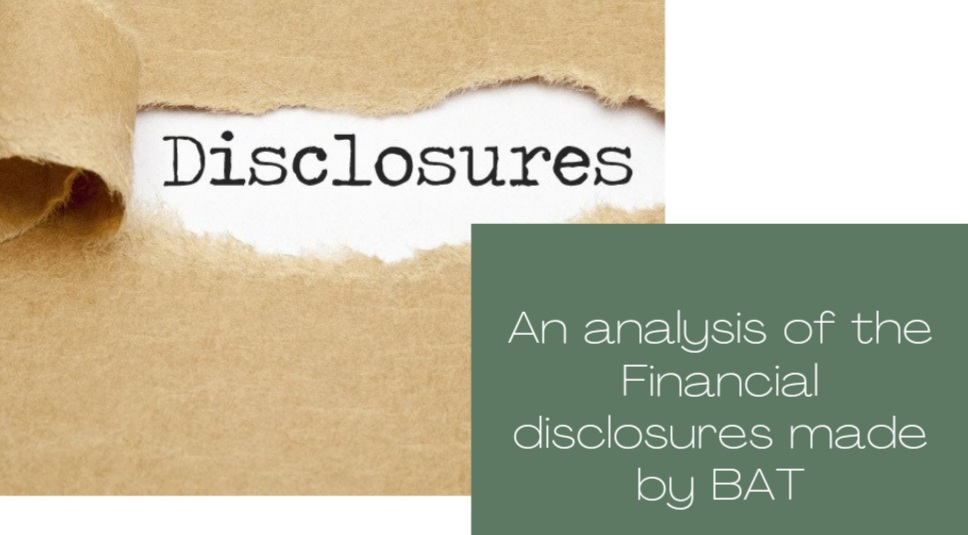
Maame Araba Abokuma Aggrey-Fynn
Mandatory financial disclosures have become a vital tool that suppresses the occurrences of business misconducts. However, it has been realized that businesses tend to give out more financial information than legally required of them. These disclosures have been subjected to numerous of debates. For this reason, this research paper seeks to investigate the types of financial disclosures and the effects they have on companies who partake in them.
This research paper makes use of academic literature of secondary information, press releases and financial statements. The British American Tobacco Company (BAT) is assessed to understand the disclosure strategies of a company in its industry (voluntary disclosures), some disclosure requirements (Mandatory disclosures) and how these requirements have changed over time.
It was concluded that although some financial disclosures are required by law aiming at protecting the interest of stakeholders, other disclosures were made by management to either subside any information that may go against the company and or to add value to it. Additionally, factors like size, and the country in which companies operate in is likely to affect the level of financial disclosures by firms.
Theoretical and practical implications of disclosures were discussed

Maame Araba Abokuma Aggrey-Fynn
Introduction.
Now Company A, a firm, is required to give out some level of information to parties such as its stakeholders and financial based organizations. Nevertheless Company A in addition to such requirements gives out information about their operations which includes charitable projects they involve themselves in. The required information Company A gives out can be considered as complusory disclosures and the information about the activities the company is not required to disclose is recongised as voluntary disclosures. The two types of disclosures come with their benefits and their disadvantages. Furthermore, research as found that factors such as Size, Country and Profitability affects the disclosures made by companies.With the above knowlege we can replace Company A with the British American Tobacco Company (BAT). Disclosure made by BAT will be analised to give as a pratical understanding of corporate disclosures.
Company overview. In 1920, the British American Tobacoo Comany (BAT) was created after the United Kingdom's Imperial Tobacoo company and the American Tobacoo company agreed to share their risk and rewards. From the company's production of cigarettes, tobacco and other nicotine products, BAT is currently the 2nd largest tobacco company worldwide operating in 180 countries and is currently worth 100.6 billion euros.Now that we Know a little about BAT we can proceed to understand what with corporate disclosures means to a company involved in them.
Disclosing ones's corporate strategy stated by Johnson, Scholes and Whittington is disclosing "the direction and scope of an organization over the long term, which achieves advantage in changing environment through its configuration of resources and competences with the aim of fulfilling stake expectations" (2008, p.3). " Voluntary disclosure is a measure of self-regulation or a response to the expectation of stakeholders and civil society for more disclosure" (Chandler, 2007). Contrarily, mandatory disclosures are required by law.What you should to know about corporate disclosures.
- Trailing the Occurrences of prominent business scandals such as the Eron case Mandatory disclosures has be come a tool that opposes the ocurrences of such misconducts (Yukins, 2015, p.1).
- Investors, management and auditors are three imperative players to disclosing Corporate Strategies.
- It has been realised that majority of the information provided by firms where not mandatory. Other disclosures made by firms were done increase the value of the firm. (Botosan, 1997, Ferreria and Rezende 2007).
- A company size, profitability and other factors with likely to affects the level of disclosure made by companies.
Advantages of Corporate disclosures.
Transparency in financial reporting: The issue of transparency in financial reporting arose after the global financial was hit with several Scandal such as the event of black September in 1997 (Mohammadi and Nezhad, 2015). This was in addition to increasing volatlity in the financial market the 1980 financial and capital market liberation increasing the need for information in order to make financial decisions. Transparenscy refers to a principle of creating a environment understandable to all market partcipants and the accountablity for the need of market participants to justify their actions and polcies and accept responsiblity fo their own actions (Lepadatu and Pirant, 2009). Through the international Accounting Standards (IFRS) and others transparency can be achieved. Disclosures companies are required to make (mandatory disclosures) ensures transparency which helps protect stakeholder interest.
Low cost of capital. Corporate disclosures, be it mandatory or voluntary has be found to reduce the cost of raising capital for the actvities of firms. For mandatory disclosures, this was factorised by the quailty of disclosures made by companies. Due to the credibility of financial boards such as the International Accounting Board (IASB), firms who prepare financial statements to meet their standards are seen as trust worth attracting more investments. For voluntary, this disclosures are more for persuaive purposes and are targeted to ginger the interest of potential stakeholders. Additionally Ferreira and Rezenda (2007) stated that since voluntary disclosures do not follow a specified format managers through mediums such as press releases are able to reach a wide range of audience promoting investment interest in potential shareholders.To help us bridge the gap between theory and practise we will be analysing some disclosures made by BAT
To restrict our analysis we are going to be taking advantage of the fact that BAT is listed on the London Stock Exchange (LSC).
Because size is a factor affecting disclosures, the company is listed on the premium market of the main market of the London stock exchange. The company is therefore obliged to disclose its financial reports on a yearly basis.
Corporate disclosures made by BAT (2020, 2019, 2015, 2011)
2020- In 2020 BAT adopted the IFRS 16 Leases. This IFRS impacted both the measurement and disclosures of leases. This standard might cause a company to develop new controls to account for the new addition in the IFRS. (BAT 2020 Annual Report.) 2019- In 2019 the strategy disclosed by BAT was that the company was aiming to double the profit obtained from their Next Generatin Products (NGP) by 2020/24 to UK euros 5 billions. The company therefore took a decision in 2019 to cut 2,300 employees globally to invest into their NGPs. British American Tobacco - British American Tobacco establishes stand-alone company, Nicoventures Limited (archive.org) 2015- In 2015 the company's strategy was aimed at developing a less risky product for their users through launching a tobacoo heating product. Next Generation Products: British American Tobacco - TobaccoTactics 2011- In 2011 BAT disclosed that their business strategy was to focus solely on the advancement and marketing of their legal approved nicotine products. To help the company achieve their goal Nicoventures Limited was establised. Next Generation Products: British American Tobacco - TobaccoTacticsComparison in relation to Academic literature.
In the year 2020, 2019, 2015 & 2011 the company engeged in the two types of disclosures, Mandatory and Voluntary disclosures. These disclosures made by the company are likely to attract investors and therefore decreases the cost of capital as stated previously as an advantage of corporate disclosures. These disclosures contain plans of securing the future of the companies and strategies that they are willing to take on to ensure the perpetual succession of BAT. Nevertheless BAT is likely to face cost relating to such disclosures. They include publication and litigation cost. Shareholders might see such disclosures as a treat to their investments or interest in the company. (2019), (2015) A factor affecting disclosures as said earlier on is profitablity. From the disclosures made by the firm and their creditablity in the industry, it reveals that the company is confident in their achievements and do not mine disclosing more. (2015), Also the company disclosure ways by which they can subtain the environment from their operations which is a requirement of the UK's Corporate Governance code concluding that the country in which the busniess operated in is a factor that affects the disclosures it makes. (2011) Lastly the company prepares their annyal reports in accordance with the IFRS with in return promotes transparency with establishes a sense of trust for potential investors. (2020)






































































































































































































































































































































































































